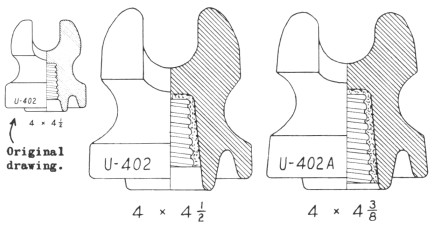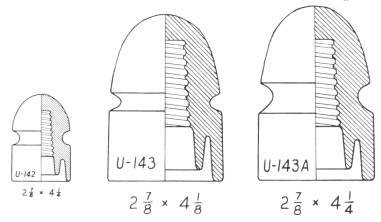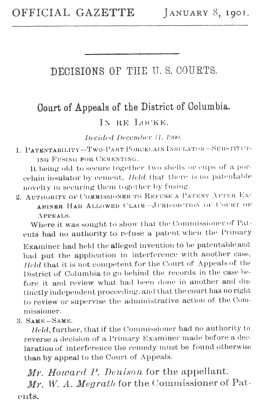Porcelain Insulator News
by Jack H. Tod
Reprinted from "INSULATORS - Crown Jewels of the Wire", May 1975, page 16
Preferably direct porcelain news items and questions directly to Jack H. Tod,
3427 N. 47th Place, Phoenix, Ariz. 85018. All mail will be answered if reply
stamp is enclosed, and the most newsworthy items and questions of general
interest will be published as space permits.
(no photo in article)
Dr. & Mrs. (Donna) Gary Bluemink, now living in Chesapeake, Va. showed up
with this insulator at the El Paso Insulator Club show two years ago, and it's
an understatement that we had some delay in getting a photo made of it!
The photo got lost in one of two moves Gary and Donna have made. Gary will be
in residency training 1-1/2 more years and would like to hear from any other
collectors in their area. (300 McCash Dr. Chesapeake, Va. 23390)
There are at least three unusual things I can think of about this insulator.
It is a scarce J-D style with a nice underglaze marking. It is a white one,
which is a bit unusual for Jeffery-Dewitt. And look at that wild radio treatment
-- the completely black groove. What an unusual insulator!
Jack
NEW BOOK
I have recently received Gerald Brown's new book, "Unique Collectible
Insulators", and although I usually describe only porcelain books here in
the porcelain column, this book is so outstanding I must make some comments on
it.
This book in a comprehensive treatment of insulators which are basically not
glass or porcelain types, and it has sections on wood, metal, "hook",
composition, rubber and plastic insulators. The section on "hook"
(ramshorn) insulators in so comprehensive and well done that I defy you to not
got interested in collecting these after you have read this treatment.
Similarly, the sections on composition and wooden insulators are just what we
have been waiting to get in print for a long time and will no doubt really got
the collecting of these under full steam.
Superb printing quality, 96 pages on the large 8-1/2" x 11" format,
softbound. At today's elevated printing costs, this in nearly a free gift at the
$4.00 price. You can order it from Gerald Brown, Two Buttes, Colo. 81084.
If you have any faith at all in my reporting being factual, take it from me
that if you don't get this book right away, you're missing the boat for sure.
Jack
FAMINE TO FEAST! 
In the January issue (page 17), we asked readers for information about the
Gisborne Pattern insulators found in Canada, and we have been deluged with
fantastically detailed information (11 pages in all!) from the following helpful
collectors: Jean Conrad (Olds, Alberta), Mrs. N. F. Illman (London, Ont. Len
Elder (Edmonton, Alberta) and Al Albright (Seattle, WA.)
Each writer quoted freely from the detailed Gisborne writeup in the book
Canadian Insulators by Colin McIntosh, 4063 W. Saanich Rd., Victoria, B.C.
($3.00 from author or OBX Library), and I'm sorry I didn't have this book in my
nearly complete insulator library until I rushed off my check for a copy after I
found out what I'd been missing.
The information about "GISBORNE" is very extensive, but not so on
the insulators themselves. These are generally chunky beehive shapes, and there
are three varieties of incuse markings: (1) small block letters, both words in
line, (2) larger block letters with the "Gisborne" over
"Pattern", and (3) large script letters, both words in one line.
Manufacturer is unknown, but the consensus opinion is that they were made by
Bullers (England). I rather think the marking originated in the fact that these
were made on special order (a nonstandard English design and with the 1"
pin hole) for Canadian lines to the Gisborne Pattern submitted to the English
manufacturer. The marking could have been specified on the orders or
gratuitously added by the factory to denote the special manufacturer's run and
for warehousing purposes.
The insulators are generally found in the western provinces but also as far
east as Ontario. Writers relate these are on Canadian lists at $4 to $6, and I
have seen them on U.S. lists at slightly higher values. I would also think the
three marking types are not equally common.
Please refer to McIntosh's book for complete details, but here is a very
brief account. Mr. N. F. Gisborne (1824-1892) was from England and ended up in
1846 employed by the British North American Telegraph Co. in Canada. He laid the
first successful underwater cable in North America (1852) and the first
Trans-Atlantic cable (1866 completion). Gisborne was very active for many years
in the expansion and improvement of communications lines throughout Canada, and
these "Gisborne Pattern" porcelain insulators were his contribution to
elimination of the hodgepodge of inferior insulators he found in use on the
various provincial lines. Judging from the historical accounts, it would seem
these are very old porcelains, the designs possibly originating as early an the
1880's.
Here is an excerpt from Len Elders's interesting letter:
"... About three years ago when the wife and I started collecting
insulators we were fortunate in obtaining a copy of Gisborne's trip by horse and
buggy across what is now known an the provinces of Manitoba, Saskatchewan and
Alberta. This report is actually the diary of his day to day Journey, and was
presented as a report to the Canadian Government.
"When we read the paragraph stating one section of line was 'upon its
last legs, the poles being rotten, the wire being No. 11 weighing 199 pounds to
the mile and much too weak for service, many of the brackets split and the
insulators of the poorest description', and recommended the line be totally
abandoned and rerouted, we decided to retrace his steps and find some of this
abandoned line.
"While waiting for summer vacation more research came up with a patent
of Gisborne's for a 16 foot galvanized, tapered, metal pole (dated August 31,
1885). He designed and installed these to overcome the severe prairie fire
damage to the wooden poles and also the problem of buffalo using them as rubbing
posts and knocking them down. As far an we could find out, about 90 miles of
them were used.
"By the end of our two week vacation we had found two of the metal
poles, complete with hardware (base plates anchor plates, etc.), a length of the
original wire used, one half of a Battleford Baby Threadless glass insulator, a
Gisborne porcelain from a later line, a gravity cell jar and the copper plates
and 'crows foot' zinc electrode, and 2 million mosquito bites!
"We now have three different Gisborne insulators. The basic shapes are
very similar; however, the two words "Gisborne Pattern" are incised
three different ways (see above) .... It is my own personal opinion they may
have been made by Bullers Ltd., London, England as they are so very similar in
appearance, design etc. to the Bullers porcelain we find in western
Canada."
The U-402 drawing in the Universal Style Chart was made from the
Jeffery-Dewitt catalog drawing, and it is being slightly revised to that shown
below (left) to agree with specimens in collections (No-Names). Additionallly,
U-402A is being added to the chart and is made from specimens showing up with an
underglaze J-D marking and first reported by Paul McManis, Excelsior, Minn.

The U-142 drawing in the style chart was made from the 1915 J. H. Parker
& Sons (jobbers) catalog, the drawings in which are notoriously poor for
representing the actual insulators. Parker sold the New Lexington & Thomas
lines, and I think this U-142 was meant to be the Thomas #1032 cataloged in 1904
and 1907 as their "W. U. TYPE". To date no specimens have been
reported agreeing with this shape.
In lieu of the U-142, we are adding the U-143 made from a specimen I found in
the Thomas dump at Lisbon, Ohio and which was probably their #1032. And also the
U-143A which is from specimens reported by Harold Anglin (Fontana, Cal). These
styles are essentially identical except for the wire groove size and position
and overall insulator height.

"THERE'S MORE THAN ONE WAY TO SKIN A CAT"
Early in the history of high voltage porcelain insulators, there was a
struggle for an advantage by several of the manufacturers involved. The fight
revolved around how to make insulators of multiple shells fused together
(glaze-welds), and the battleground was generally the patent examiner's office
and in various courtrooms.
Attached to this article are just two enlightening court decisions involving
Fred Locke and his difficulties with "glaze-weld" patents in general
and with the Boch patent in particular.
Apparently the starting point is where Imperial Porcelain Works was
experimenting with glaze-welds for Locke in January 1897. Locke had subsequently
filed a patent application Feb 5, 1897, but this was ultimately rejected,
appealed, and again rejected.
Meanwhile, Boch (for Thomas) had made a patent application and which was
thrown into interference proceedings with the Locke application in September
1897.
Under court rules, Boch had access to Locke's file in the patent office, and
when Boch filed a new application on the "glaze-filling" process on
Oct. 23, 1897, Locke later accused Boch of stealing the idea from Locke's
application -- if indeed it was patentable at all.
But Locke's application said nothing about the use of extra glaze to fill all
voids and cracks as did the Boch application. Boch was awarded the
"glaze-filling" patent on March 8, 1898.
Locke persisted in trying to get a patent (any patent!) on a fusing process,
and note that one application was carried all the way to the Court of Appeals
where it was again denied on the basis that merely fusing porcelain parts
together wasn't novel. (See Dee 11, 1900 decision.)
In the Thomas suit against Electrical Porcelain & Mfg. Co. and Fred
Locke, Locke didn't dispute that there had been an infringement on the Boch
patent if the Boch process was indeed patentable, but which they contended it
was not. But this didn't not too well with the judge in light of the fact that
after Boch was granted the patent in 1898, Locke himself then endeavored to
obtain a patent for the same identical process, copying the Boch application
verbatim! (Locke obviously speak with forked tongue -- and now caught in his own
trap.)
In any event, Thomas won the suit, and the validity of the Boch patent of
March 8, 1898 was sustained. Locke and others were ordered to make an accounting
for damages.
EPILOGUE
Fred Locke evidently took off a couple of months to lick his wounds, but he
then took off in a new direction with rapid fire patent applications of March
12, April 19 and May 5, 1902 - all for processes generally involving
glaze-welding insulator shells per se. (See O.G. patent clips at end of this
article.) He undoubtedly reminded his patent attorneys of his past patent
difficulties where simple fusing was deemed unpatentable and that a particular
method of doing it was essential in the patent claim.
So, while there was the Boch Process patent making perfect insulators by
filling all nooks and crannies with glaze, here was old Uncle Fred with his
patent #754,284 for the least perfect insulator ever made - a glazeweld with air
spaces purposely left between the shells.
Then there was his patent #702,661 where molten glaze was to be poured in the
crack to do the welding, but this undoubtedly fizzled when they couldn't get a
volunteer to enter the kiln at 2200 degrees F to pour in the molten glaze.
But the crowning achievement was Locke's patent 702,660 - a carbon copy of
the Boch process, filed 8 days short of 4 months from the date the Boch Patent
was upheld by the courts. Whereas in the Boch process the shells were nested and
then the glaze poured into them, the Locke process was to just dip up that same
amount of glaze in the outer shell and then set the inner shell down in that.
There's more than one way to skin a cat. This patent was granted to Locke June
17, 1902, and it undoubtedly ended his problem of making
"glaze-filled" insulators just like Thomas was making, yet technically
not infringing the Boch Process patent of 1898.
I'm sure you can't help but notice the drawing in this Locke patent is a
direct copy of the Thomas insulator shapes made under the Boch patent, and
that's really thumbing your nose at the opposition. Yes, Fred was really a foxy
old devil, and he probably had an ear-to- ear grin on his face when he went down
to the tool room and told them to change the 6-patent-date insulator marking
stamp to a new one with 7 dates by adding JUNE 17, 1902.

CJ pg 26 - Large Image
(~400K)
| 